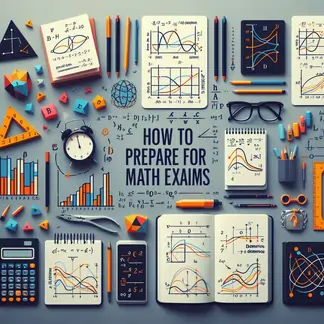How to Prepare for and Ace Math Exams with Graphs, Derivatives, and Equations

Facing a math exam that involves graph interpretation, critical point analysis, and differentiation can feel overwhelming, especially when time is limited, and accuracy is crucial. However, with the right preparation techniques and practical strategies, you can turn these challenges into opportunities for success. Whether it's understanding the behavior of functions, solving complex derivatives, or mastering critical points, the key lies in consistent practice and smart study methods. In this comprehensive guide, we will walk you through effective ways to prepare for math exams that demand a strong grasp of calculus concepts. From interpreting graphs to applying the first and second derivative tests, we’ll cover it all. Additionally, we’ll share actionable tips for managing your time and answering questions with confidence during the exam. If you're seeking a "Math Exam Helper" or need reliable "Online Exam Help," this guide will equip you with the strategies you need to excel and achieve top scores. Let's get started on mastering your math exams!
Understanding the Key Areas of Focus

The first step towards mastering math exams is understanding the core areas of focus. Most math exams like the one you are preparing for emphasize graph interpretation, behavior analysis, critical point identification, and differentiation rules.
1. Graph Interpretation and Behavior Analysis
Graph interpretation is crucial in understanding how a function behaves under different conditions. It is common to encounter questions where you are given a graph and asked to determine where the function increases, decreases, or changes concavity.
a. Understanding the Function and Its Derivative
Graphs can describe the behavior of a function f(x) along with its first derivative f′(x) and second derivative f′′(x). To excel in these questions, you must understand how these elements correlate.
- f(x): This represents the function’s actual value at any point on the graph. Peaks, valleys, and inflection points are visible directly from this graph.
- f'(x): The first derivative indicates the slope of the function. If the slope is positive, the graph is increasing. If the slope is negative, the graph is decreasing.
- f''(x): The second derivative determines the concavity of the function. Positive concavity (upwards curve) suggests a local minimum, while negative concavity (downwards curve) suggests a local maximum.
Pro Tip: When answering graph questions, look for points where f′(x) = 0 as these often indicate critical points like peaks or valleys.
b. Identifying Critical Points
Critical points are where the slope of the function changes, often representing local maxima, minima, or points of inflection. Identifying these points requires understanding the behavior of f′(x) and f′′(x).
Steps to Identify Critical Points:
- Differentiate the function to get f′(x).
- Set f′(x) = 0 to find critical points.
- Use f′′(x) to test if the critical point is a maxima, minima, or inflection point.
- Plot these points on a rough graph to visualize behavior.
Pro Tip: Always interpret critical points within the context of the graph provided.
c. Matching Graphs to Function Behavior
Matching graphs to a given function requires a firm understanding of the relationship between a function and its derivatives.
- Upward slope → Positive f′(x)
- Downward slope → Negative f′(x)
- Change from upward to downward slope → Local maxima
- Change from downward to upward slope → Local minima
- Point where f′′(x) = 0 → Possible inflection point
Practice Tip: Attempt at least 30 graph-matching questions before your exam to build speed and accuracy.
2. Finding Critical Points and Extrema
Critical points and extrema play a major role in understanding a function’s behavior. You will frequently encounter questions that require you to find maxima, minima, and inflection points.
a. Using the First Derivative Test
The first derivative test is a simple yet powerful method to identify local maxima and minima.
Steps to Apply the First Derivative Test:
- Differentiate the function to find f′(x).
- Set f′(x) = 0 to find critical points.
- Test values around the critical points to determine increasing or decreasing behavior.
- If the slope changes from positive to negative, it's a local maximum.
- If the slope changes from negative to positive, it's a local minimum.
b. Using the Second Derivative Test
The second derivative test provides another method for finding maxima or minima.
Steps to Apply the Second Derivative Test:
- Differentiate the function to find f′(x) and f′′(x).
- Set f′(x) = 0 to find critical points.
- Substitute critical points into f′′(x).
- If f′′(x) > 0, it's a local minimum.
- If f′′(x) < 0, it's a local maximum.
Pro Tip: If f′′(x) = 0, the test is inconclusive.
c. Real-Life Application of Extrema
Understanding maxima and minima can be practically applied in fields like:
- Economics: Finding maximum profit or minimum cost.
- Physics: Identifying peak velocity or force.
- Engineering: Determining stress points in materials.
By connecting math to real-life situations, it becomes easier to grasp the concept of extrema.
3. Applying Differentiation Rules
Differentiation rules are fundamental in solving questions involving product functions, quotients, and chain functions. Most math exams heavily test these rules.
a. Product Rule
The product rule is used when differentiating two multiplied functions.
d/dx[u × v] = u'v + uv'
Example:
d/dx[x^2 × e^x] = 2x e^x + x^2 e^x
b. Quotient Rule
The quotient rule applies when differentiating one function divided by another.
d/dx[u/v] = (u'v - uv') / v^2
Example:
d/dx[x/(x+1)] = ((1)(x+1) - (x)(1)) / (x+1)^2
c. Chain Rule
The chain rule is used for nested functions.
d/dx[f(g(x))] = f'(g(x)) × g'(x)
Example:
d/dx(e^(x^2)) = e^(x^2) × 2x
Practice Tip:
- Master each rule by solving 30+ problems.
- Always cross-verify your answers.
Effective Exam Hall Strategies
1. Time Management
Manage your time efficiently by:
- Spending 30% of time on easy questions.
- Devoting 50% of time to medium-difficulty questions.
- Using 20% of time for challenging or graph-related questions.
2. Answer Verification
Always double-check your answers by:
- Substituting critical points into the original function.
- Verifying slope behavior for maxima/minima.
3. Graph Sketching
If the exam allows, sketch a rough graph to visualize function behavior.
Final Preparation Checklist
- Master product, quotient, and chain rules.
- Solve 50+ graph-related questions.
- Practice under timed conditions.
- Review all mistakes and correct understanding.
By following these strategies and practicing consistently, you will significantly improve your chances of acing any math exam that involves graph analysis, differentiation, and critical point identification. Good luck!